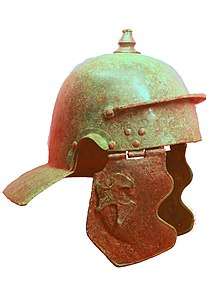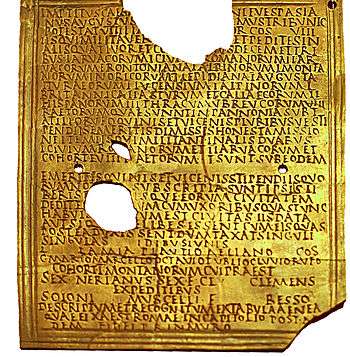Cohors II Lucensium
The Cohors II Lucensium [equitata] (2nd cohort from the Conventus lucensis [partly mounted]) was a Roman auxiliary unit. It is attested by military diplomas and inscriptions.
| Cohors II Lucensium | |
|---|---|
 Roman infantry helmet (late 1st century) | |
| Active | early 1st century to at least early 3rd century |
| Country | Roman Empire |
| Type | Roman auxiliary cohort |
| Role | infantry/cavalry |
| Size | 600 men (480 infantry, 120 cavalry) |
| Garrison/HQ | Moesia, Pannonia, Moesia Inferior, and Thracia |

Name
- Lucensium: from the conventus Lucensis. The soldiers of the cohort were recruited, at least initially, from in the territory of conventus Lucensis with the capital Lucus Augusti (modern Lugo), Spain.[1]
- equitata: partly mounted. The cohort was a mixed unit of infantry and cavalry.
Since there is no evidence for the suffix milliaria (1000 men), the unit was a cohors quingenaria equitata. The target strength of the cohort was 600 men, 480 infantry and 120 cavalry, consisting of 6 centurias of infantry with 80 men each and 4 turmae of cavalry with 30 men each.
History
The cohort was stationed in the provinces of Moesia, Pannonia, Moesia Inferior, and Thracia, in that order. It is listed on military diplomas for the years 78 to 180/192 AD.[2][3][4][5] The cohort's deployment in 80 in the province of Pannonia is controversial.
The first evidence of the unit in the province of Moesia is based on a military diploma dated to the year 78. The diploma lists the cohort as part of the troops stationed in the province. Further diplomas, dated 92 to 127, place the unit in Moesia Inferior.
Around 130 a vexillatio of the unit was stationed in Chersonesus in Crimea.[6]
The first evidence of unit in the province of Thracia is based on a military diploma dated to 138. The diploma lists the cohort as part of the troops stationed in the province. Other diplomas dated from 155 to 180/192 attest to unit in the same province.
Stations
Locations of the cohort in Moesia and Thracia were possibly:[2] [6]
- Abritus (Razgrad)
- Germania in Dacia (Sapareva Banya)
- Kabyle
- Montana, Bulgaria
Members of the cohort
he following members of the cohort are known.[2]
Commanders
- []s Philippus: he is named in a diploma of 180/192 as commander of the cohort.
- Claudius Lupus, a prefect (c. 135)
- Flavius Maximianus: he is named in a diploma of 160 as commander of the cohort.
- Lucius Pollius Gratus, a prefect (c. 195)
- Publius Gavius Balbus[1]
- T(itus) Herennius Niger, a prefect (c. 217/218)
- Ulpius Marius, a prefect
Others
- Aelius Tarsas, a centurion
- Auluzenis, a soldier
- Aurelius Saturninus, a soldier
- Caius Iulius Maximus, a cavalryman
- Flavius Mestrius Ius[tus], a soldier
- M(arcus) Antonius Valens, a soldier
- Rescuporus, a foot soldier
Uncertainty
The military diploma, issued for the province of Pannonia, dated 13 June 80 AD, lists Cohors I Lucensium in one place and Cohors II Lucensium elsewhere. John Spaul, Jörg Scheuerbrandt and Margaret M. Roxan assign the diploma to Cohors I Lucensium, while Agustín Jiménez de Furundarena to Cohors II Lucensium,[7] leading to uncertainty over the presence of the cohort in Pannonia.
See also
- Roman auxiliaries
- List of Roman auxiliary regiments
References
| Wikimedia Commons has media related to Cohors II Lucensium. |
- Roxan, Margaret M. "THE AUXILIA OF THE ROMAN ARMY RAISED IN THE IBERIAN PENINSULA, vol 1" (PDF). University College London. Retrieved Apr 8, 2019.
- Spaul, John F. (2000). Cohors 2. BAR Archaeopress. ISBN 978-1841710464. Retrieved Apr 8, 2019.
- Scheuerbrandt, Jörg. "Exercitus. Aufgaben, Organisation und Befehlsstruktur römischer Armeen während der Kaiserzeit". Uni Freiburg (in German). Retrieved Apr 8, 2019.
- Țentea, Ovidiu; Matei-Popescu, Florian. "Alae et Cohortes Daciae et Moesiae". researchgate.net. Retrieved Apr 8, 2019.
- Roxan, Margaret M. "THE AUXILIA OF THE ROMAN ARMY RAISED IN THE IBERIAN PENINSULA, vol 2" (PDF). University College London. Retrieved Apr 8, 2019.
- Ruscu, Ligia (2005). "Two Pontic Notes" (PDF). Epigraphica Anatolica (38): 125–130. Retrieved Apr 8, 2019.
- De Fundeaena, Agustín Jiminéz. "The Cohors I Lucensium Equitata". academia.edu (in Spanish). Retrieved Apr 9, 2019.